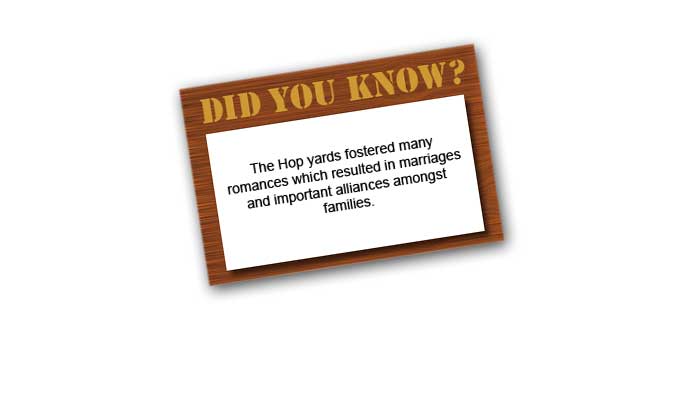
The Workforce
From the early 1890s to 1997, many cultural groups participated in the annual hop picking harvest. In the earlier years, particularly before 1940, the companies absorbed costs for hiring and retaining a steady, stable work force. This meant offering a variety of incentives to workers. Travel costs, whether by British Columbia Electric Railway from Vancouver or Canadian National Railway or Canadian Pacific Railway from the interior, were covered by the growers. Cabins in the hop yards were provided and sometimes free wood, potatoes and medical services formed additional incentives. The work force included Aboriginals, Mennonites, Chinese, Japanese, south Asians and Euro-Canadians.
Hop Workers - First Nations
Joe Aleck in a 1990 interview recalls:
"When I was out in the hop yards, I was quite young at the time so I wasn’t doing other things other than picking hops…Well, I think pretty well my whole family was there. My brother and my four sisters and …I mostly worked with my great grandmother. She was going on a hundred. I imagine she’s be ninety seven, ninety eight at the time. And I used to help her walk out into the field. She couldn’t see too well so I’d help her and also bring her the vines so she could pick the hops."
Up to the mid-1920s most of the labour needed to pick the crop came from aboriginal communities scattered throughout British Columbia and Washington State. First Nations people would travel from Port Simpson on the British Columbia coast, the Nass and Skeena Rivers in the north, Vancouver Island, Lytton and Lillooet in the interior, Washington and Oregon States and the Fraser Valley to pick hops in the local fields.
Cecil Shaw who with his wife Lorna operated one of the hop yard stores said in a 1989 interview:
“I really think that the native people were the backbone of the hops.”
(Chilliwack Archives, November 15 1989, Acc. # 990.12)
By 1927, the complexion of the industry was changing. The Dominion Department of Immigration was refusing entry of Washington State aboriginals to Canada and this exacerbated a labour shortage at a time when the industry was undergoing a massive expansion. As well, by the mid-1920s, a perception was developing that an “all-white picking force would be more efficient and economical than an all-native or mixed force.” (Chilliwack Progress, June 2 , 1926, 1)
Predictions were, according to E. D. Barrow, the Provincial Minister of Agriculture that a complete change in the ethnicity of the work force was coming.
Barrow’s prediction didn’t materialize completely. The B. C. Hop Company and the Hulbert Hop Company continued to employ aboriginals but two new companies, the Canadian Hop Company and the John I. Haas Hop Company, looked to local and Vancouver non-aboriginal communities for help. The grower’s felt that by using local, non-aboriginal picking crews “this much additional purchasing power, as understood in terms of white standards of living, will have a beneficial effect upon the economic life in part of the Lower Mainland in which development will be taking place” (Chilliwack Progress, June 2, 1926, 1).
Until picking machines replaced people in the 1950s, the labour force in the hop fields continued to reflect the ethnic and cultural diversity that characterized Fraser Valley communitites.
Hop Workers: Mennonites
Mennonites joined the industry in the late 1920s and later just when a series of global and local events led to their acceptance into Canada and eventually to the Fraser Valley.
When Mennonite families migrated to Yarrow in 1928 and the years following, most arrived with little or no cash and very few assets. Having fled the Soviet Union because of religious and economic persecution following the Russian Revolution of 1917, these families were lured to the area with the thought that plentiful and cheap land would provide them with an opportunity to create a new Mennonite settlement, one that would be modeled after the settlements they had left behind.
The first few years that the refugees were in Canada were spent mostly in the vicinity of older Mennonite communities on the Prairies whose families fled in the 1870s to avoid similar conditions as the latter group. Life on the Prairies was not easy. Harsh living conditions, crop failures and the lack of opportunities were reasons that most families remained open to further change in their already disrupted lives.
Fortuitously, by 1927, Chauncey Eckert, a successful Chilliwack developer, chose to subdivide his vast landholdings that were located south of Chilliwack in the lush Fraser Valley. Advertisements for Eckert’s land caught the attention of several families and, after, 1928 many Mennonite families began settling in what was to become the community of Yarrow. Fortunately, for the families, they arrived in the Fraser Valley at a time when the production of hops was undergoing massive expansion. The need for new workers was acute. Work in the hop yards provided much needed income for many Mennonite families.
The experiences of Mennonites mirrored those of aboriginal, Chinese, Japanese and Euro-Canadian workers. Because labour crews were separated by cultural group, languages and certain aspects of the differing cultures were preserved or at least temporarily protected from change. Family and community ties could be maintained.
For the producers, this had two major ramifications. First, family units tended to pick more hops. Cecil and Lorna Shaw who operated a hop yard store talked about the depression years and the benefits of harvesting by ethnic groupings.
Cecil Shaw remembers:
“We had a bunch come up here once I remember. They were on welfare. Well welfare in Vancouver in those days was pretty slim. You had to go and beg to get it. …They came up here and those fellows were individuals. They picked alone.” [Lorna Shaw comments that “They could never get their boxes full.”] Cecil Shaw agrees and asserts strongly that “Never! Never! They’d get a bag full and pour it into the box and be half full or a third full. I think it took about three bags. Come out the next morning, it was down a quarter. This went on. It was just after I started, ’34 or ’35.”
In contrast, Mennonites picked as a family unit and thus increased production, adding to the families income. Money earned in the hop fields by individual family members was used by the parents for family expenses and supported the family unit. Walter Harder echoes this attitude:
“We went straight from harvesting the hops to the Eaton’s catalogue didn’t we? Mother would make a list of all the things that we needed together with the price and then when she had finished then she added up the cost and it was nearly always much more than we were able to pay. Well then she said “now I will have to scratch out the ones that are a lower priority”. And what she did, she took the things off that she needed.”
In addition to gaining increased production from family-centred picking crews, a second benefit for the producerswas the pejorative view of strikes taken by Mennonites. Strikes were simply not in most Mennonite’s vocabulary. Peter Harder was five or six years old when he recalled seeing a group huddled together a little distance from where they should be picking. He learned from his father that this was a sit-down strike.
"Yeh, they wanted more money per pound. But the company, they knew the ethnic Mennonite people would not go on strike because that is against our principles for one thing and there wasn’t enough unity among us to speak the language. The ethnic Mennonite people were quite safe when it came to labour action and the Japanese likewise. They were not indoctrinated into labour action to gain high prices…."
Many Mennonite families continued to move to Yarrow throughout the 1930s to 1950s, providing the local hop yards with a dependable source of labour. This was an arrangement that suited both Mennonites and the producers.
Hop Workers: Chinese and Japanese
Chinese and Japanese workers also united in the work of separating the hops from their vines. Some single Chinese male workers worked throughout the year and these workers were able to send money to their families that remained in China.
Japanese farm workers from Mission and other Fraser Valley centres actively participated in the hop industry until World War Two when internment camps were established to house Japanese-Canadians who were perceived as a threat to Canadian security. One poignant letter from one of Ord’s Japanese pickers, written at the beginning of 1942, asked Ord to take care of the kitchen utensils that he had left in a cabin at the end of the previous season. He mentioned that he was being removed from the coast to an internment camp. Ord, in the return letter, promised that he would.
In the late 1930s, Japanese in Mission experimented with growing hops but their efforts were thwarted when they were displaced from the coast in 1942. After the war, Japanese workers did not return to the hop fields.
The Average Day of a Hop Worker
Hop picking season was both a time of work and play. While the work was hard, many look back at the picking season as a time for social interaction when life-long friendships and romances began or were nurtured. Since the workforce stayed with their own ethnic group, each had their own forms of entertainment. First Nations people, the most predominant group in the industry, enjoyed sla’hal games, foot and horse races. Chinese workers played mahjong while the Japanese built small bathhouses. Card games were popular among all groups.
The living, working and recreational conditions of the culturally diverse picking force varied over the historical time period of the industry. Each group worked in isolation but their experiences had a commonality. Some daypickers returned to their homes each evening to face chores such as milking cows, preparing meals and washing clothes. Boarders were usually so exhausted after working long hours, a bath or shower to get the lupulin (hop oil and dust) off their bodies, a filling meal, some socializing and early to bed were daily routines.
At its height in the 1940s, the industry employed up to 4,000 people. By the mid-1950s picking machines were introduced and the large crews were no longer needed. It is estimated that one picking machine could handle up to 50,000 pounds of hops per day or the equivalent production of 400 to 500 pickers. It was just a matter of time before picking machines were introduced to all hop farms.
Hop Worker Cabins
In the early 1930s, while some workers still lived in tents, more and more would live in cabins, also called bunkhouses, on the hop yard. Walter Harder described the cabins as follows:
“They were much lower, flatter and the front was all burlap. There was no wooden door, just all burlap…If you wanted to go out you just lifted the burlap and went out…There was not much security and you had dirt floors and you had a stove about this big, made out of metal with a little door…You put wood in there and burn your porridge on there and you can have some breakfast. And then there was the second level, it was a split level, dirt, then you went up one step. And then you had bunks on both sides - two people here and two people here. And the table was like this and had hinges and the cupboards with all the utensils was here and the table would be lifted up and you close up the cupboard and the foot on the end would hinge down and your could put a padlock on here. So you wouldn’t lose your utensils cause there was no security. One light in the middle witha turner on it and a 40 watt bulb. That was living in cabin."
Online exhibit (c) Chilliwack Museum and Archives 2008. About the Exhibit


